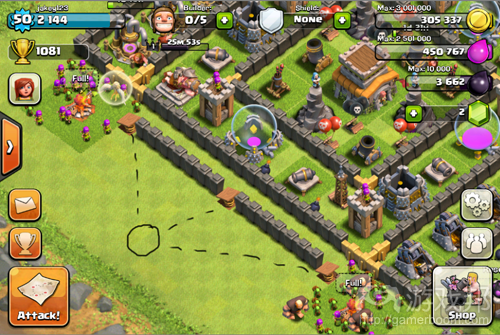游戏盈利机制避开“花钱获胜”的3个方法
作者:Yaniv Nizan
在免费游戏中,现家面临着一个矛盾:一方面想花钱克服挑战,另一方面又希望保持游戏的挑战性。这就像吃了手上的蛋糕还希望蛋糕留在手上。借本文,我们来看看这个所谓的“花钱赢”问题,并解决它。
你和我一样,希望留住购买IAP的玩家,给他们一个有趣的游戏世界。好吧,考虑到你只打算从玩家身上得到1%到2%的钱,那么做你坚持不了太久的。然而,这不是这个方法的主要问题。
这个问题是,一旦你给玩家所有解决难题的答案,游戏就不再有挑战性了,进而玩家就失去兴趣了。你必须知道,任何解决这个悖论的方法的前提都是,你的游戏不仅有短期的、能立即得到的奖励,还要有长期的、很难得到的奖励。
这是因为玩家头脑中有两种想法。当玩家把自己当成角色时,他只想克服挑战;而当玩家跳出角色时,他其实希望留住挑战。
以下是解决这个矛盾的办法:
1、“剃刀和刀片”法
这个办法的思路是,以现金或游戏金钱出售增益道具,但事实上,玩家获得这种虚拟道具需要消耗一些玩家拥有但有限的东西。
好吧,我说的还是有一点模糊,那我就举例子吧。比如,你可以出售小车,但你要保证玩家还必须获得汽油;激光武器要消耗能量;5级的兵营可以训练超级战士但需要大量金子……
如果你采纳我在另一篇文章中给出的建议,应该不难做到。你的游戏世界中已经有可消耗的资源,所以我建议你把它作为你的虚拟道具的资源。这样,在玩家购买虚拟道具后,他在使用道具时就要非常慎重。结果是,游戏不仅更有挑战性了,而且更复杂和有趣了。
2、下一级难度总是+N而不是+1
对于数学狂人来说,这个办法就相当于O(n^2) vs. O(n)的难度曲线。简单地说就是,下一级总比上一级难得多。
仍然有简单的级数,但下一级的困难程度是递增的。以《Clash of Clans》为例,建造一个5级的市政厅的资源消耗量是4级的2倍,而不是多花1000金子那么简单。这样,付费玩家虽然可以花钱跳级,但游戏难度很快又会赶上他。
3、概率
这是百试百灵的办法。具有运气元素的游戏与结果确定的游戏相比,更能吸引玩家。如果高级队伍总是赢,那么任何团体运动都会很无聊的。当你觉得两支队伍都可能胜利时,团队运动才有看点。这就是运气元素对游戏的作用。
说到保持游戏对付费玩家的挑战性,运气元素的作用就更明显了。“花钱可以买来胜率,但不能买来胜利”符合生活现实,也是一种保持挑战性的好办法。如果破坏一辆坦克需要5枪,那么你可以出售一枪打爆一辆坦克的武器或者具有20%出爆击的武器(游戏邦注:也就是,这种武器一枪解决一辆坦克的概率是20%,但一般时候仍然需要5枪)。
大部分成功的游戏会综合运用几种方法。务必记住,以上三种方法虽然降低了角色价值,但提高了玩家价值。(本文为游戏邦/gamerboom.com编译,拒绝任何不保留版权的转载,如需转载请联系:游戏邦)
Three ways to prevent pay-to-win
by Yaniv Nizan
One of the paradoxes of free-to-play games is that the user wants to buy his way out of the challenge but also keep the game challenging. That’s like eating the cake and having it too. Let’s take a look into this problem, which is also known as “pay-to-win”, and solve it.
If you are anything like me, you want to hug the users who make in-app purchases and give them the world. Well, given that you are only going to get money out of one per cent to two per cen of your users, you wouldn’t get very far by doing that. However, this is not the main problem with this approach.
The problem is that once you give the user all the keys the game stops being challenging and the user loses interest. It’s critical to understand that any solution to this paradox requires selling the products that have an immediate reward in the short-term but actually make it harder in the long-term.
This is a result of the user thinking in two hats at the same time. While in character, the user just wants to solve the challenge, but once he is out of character, he actually wants to keep the challenge.
Here are a few ways how to get around this:
THE RAZOR AND RAZOR BLADE APPROACH
The idea here is to sell a great Power-up for cash or premium game currency but actually requiring this virtual good to consume something that the player has some but limited access to.
Ok, this was a bit vague so here are a few examples. You can sell a car, but make sure the player needs to also get fuel, laser weapon consumes energy, Barracks level 5 can train super troops but requires a lot of gold to do that.
It’s usually not very hard to build a narrative around it and if you followed advice I gave in other posts, you already have a consumable resources that makes sense in the world you built so I would recommend to use it as the resource for your killer virtual good. This creates a situation where the after buying the virtual good the user needs to make tough decisions about how to use it. We have not only made the game as challenging but also more complex and interesting.
THE NEXT LEVEL DIFFICULTY IS ALWAYS +N RATHER THAN +1
For the math geeks this will translate into an O(n^2) vs. O(n) difficulty curve. For you humans – it just means that the next levels are becoming more difficult in comparison to the last levels.
There could still be easy levels and harder ones but the hard levels should get increasingly harder. In Clash of Clans for example, building a City hall Level 5 will cost twice as much as Level 4 and not 1,000 gold coins more. This creates a situation where a paying user skips a few levels but the game is quickly catching up with him.
RANDOMISE …. EVERYTHING
This is a good general advice. Games with a luck component engage users longer compared to games with determined result. Any team sports would have been boring as hell if the superior team always won. Why bother showing up? It works so much better when you feel both teams can win. That’s what a luck component gives your game.
This is especially true when it comes to keeping the challenge for paying users. “You can buy better odds but you can’t buy victory” is in-line with real life and is also a sure way to keep the challenge. If it takes five shots to blow up a tank, you can sell a weapon, which blows up a tank in one shot or you can sell a weapon that has a 20 per cent of making a critical hit and blowing up a Tank in one shot and will otherwise still blow it up in five shots.
These are not necessarily distinct approaches and most successful games actually combine a few of these. The important thing to remember is that while all three approaches give the character less value, they give the user more value.(source:develop-online)








































 闽公网安备35020302001549号
闽公网安备35020302001549号